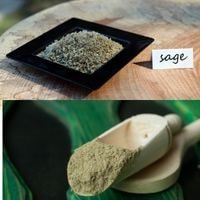Can I Use Rubbed Sage Instead Of Ground Sage – is the article you’re searching for. Hopefully, you can find information related to Can I Use Rubbed Sage Instead Of Ground Sage here, all of which we’ve summarized from various reliable sources.
In the culinary world, herbs play a pivotal role in transforming ordinary dishes into extraordinary culinary masterpieces. Among the most versatile and widely used herbs, sage stands out with its distinctive earthy aroma and slightly peppery flavor. Its culinary prowess extends to a variety of dishes, ranging from savory roasts to aromatic stuffing and flavorful sauces. Whether fresh or dried, sage adds a touch of magic to any culinary creation.

Can I Use Rubbed Sage Instead Of Ground Sage
When it comes to incorporating sage into your culinary adventures, you may encounter two primary forms: ground sage and rubbed sage. Ground sage, as its name suggests, is sage leaves that have been finely ground into a powder. This powdered form offers convenience and ease of use, as it readily blends into dishes, imparting its flavor in a uniform manner. Rubbed sage, on the other hand, consists of dried sage leaves that have been gently rubbed between the palms to release their aromatic oils and create a coarse, crumbly texture.
Rubbed Sage: A Textural Adventure
Rubbed sage stands out from its ground counterpart due to its distinct textural qualities. Unlike the fine powder of ground sage, rubbed sage retains a slightly coarse texture, providing a subtle yet noticeable crunch when incorporated into dishes. This textural element adds an unexpected dimension to culinary creations, offering a pleasing contrast to the smoothness of sauces and the tenderness of meats.
The unique texture of rubbed sage also lends itself to creative culinary applications. Its coarse nature makes it an ideal coating for roasted vegetables, providing a delectable crunch and a burst of flavor with each bite. Additionally, rubbed sage can be sprinkled over pasta dishes or salads, adding both a flavorful and visually appealing touch. Its versatility extends to bread-making as well, where its inclusion imparts a rustic charm and a delightful herbal aroma.
Interchanging Rubbed and Ground Sage: A Matter of Preference
While both rubbed and ground sage offer distinct advantages, the choice between them often boils down to personal preference and the specific dish being prepared. When seeking a uniform distribution of sage flavor throughout a dish, ground sage proves to be the preferred option. Its fine texture ensures that its flavor permeates every nook and cranny, making it ideal for sauces, soups, and stews.
However, if you desire a more pronounced textural element and a more intense burst of sage flavor, rubbed sage emerges as the superior choice. Its coarse texture adds a delightful crunch and a more concentrated flavor profile, making it particularly suitable for dishes where sage is meant to take center stage, such as roasted meats, vegetable platters, and herb-infused breads.
Tips and Expert Advice for Sage Connoisseurs
To elevate your culinary adventures with sage, consider the following expert tips:
- Freshness Matters: Opt for fresh sage whenever possible, as it offers the most vibrant flavor and aroma. If using dried sage, choose high-quality brands and store it in an airtight container to preserve its potency.
- Quantity Control: Sage is a potent herb, so use it judiciously. Start with a small amount and gradually increase until you achieve the desired flavor intensity.
Harnessing the wisdom of culinary experts, let’s delve deeper into these tips:
When selecting fresh sage, look for leaves that are deep green in color and free of blemishes. Avoid leaves that are wilted or bruised, as they indicate a loss of freshness and flavor. To preserve the freshness of fresh sage, store it in a damp paper towel in the refrigerator for up to a week.
When incorporating sage into your dishes, begin by adding a small amount and taste as you go. This approach allows you to fine-tune the flavor intensity to your liking and avoid overpowering the other ingredients. Remember, you can always add more sage, but removing its excess can be a culinary conundrum.
Sage Wisdom: Frequently Asked Questions
Q: Can I substitute rubbed sage for ground sage in all recipes?
A: While substitution is generally possible, it is important to consider the specific dish and the desired flavor profile. Rubbed sage imparts a more intense flavor and a distinct texture, which may not be suitable for all recipes.
Q: How much rubbed sage is equivalent to ground sage?
A: As a general rule, 1 tablespoon of rubbed sage is approximately equivalent to 2 teaspoons of ground sage.
Q: What are some creative ways to use sage?
A: Beyond its culinary applications, sage can also be used to create aromatic infusions for tea, or as a natural air freshener when burned.
Conclusion
Embarking on a culinary journey with sage presents a delightful opportunity to explore its versatility and unique flavor profile. Whether you prefer the fine texture and uniform distribution of ground sage or the coarse crunch and intense flavor of rubbed sage, both forms offer a captivating sensory experience. By understanding the nuances of each type and incorporating expert advice into your culinary creations, you can harness the power of sage to transform ordinary dishes into extraordinary culinary delights.
So, the next time you find yourself contemplating the sage aisle, take a moment to consider the desired flavor and texture you seek. With this newfound knowledge, you can confidently choose the perfect form of sage to elevate your culinary masterpieces and embark on a flavorful adventure that will tantalize your taste buds and leave a lasting impression.
Can I Use Rubbed Sage Instead Of Ground Sage

Image: foodmorning.fr
Can I Use Rubbed Sage Instead Of Ground Sage has been read by you on our site. Thank you for your visit, and we hope this article is beneficial for you.